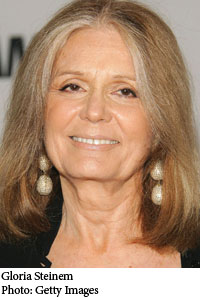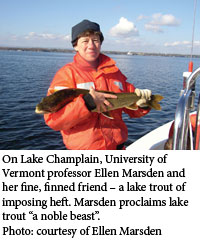Gloria Steinem: Feminist Warrior at 75!
Coming to Burlington June 11
Why Steinem Matters More Than Ever
Gloria Steinem matters because for the last 40-plus years she has played one of the major roles in the modern women’s movement. Because of her unrelenting fervor as a political organizer, activist, writer, lecturer, author, and editor she is the world’s most renowned feminist and women’s rights activist. The contributions of Gloria Steinem matter because history matters: more specifically, because women’s history – so often unknown, diminished or erased – matters. It is vital that we remember and acknowledge the groundbreaking efforts of individuals such as suffragists Elizabeth Cady Stanton and Susan B. Anthony, whose shoulders we stand on.
Future generations, in turn, will stand on Gloria Steinem’s shoulders, their lives all the stronger thanks to her remarkable contributions.
Steinem sees one of her important roles through the years as that of traveling organizer. She makes the trek everywhere from rural college campuses to developing world countries, from major cities and special events to small towns – including, this month, to Burlington as the keynote speaker for the Vermont Woman Speakers Series. By doing so, she intimately connects with people in one room, reaching out, to provide historical perspective, to inspire – and most importantly, to motivate us to commit “outrageous acts” for simple justice, to paraphrase her classic book. On June 11 at the Hilton in Burlington, Gloria will spend some invaluable time with Vermonters, speaking to all of the above and much more.
Read the full article |

|
| |
|
Feminism’s Champion – Ms. Gloria Steinem
“Gloria’s calling, Gloria’s calling!”
The news buzzed among the student protesters at Texas Women’s University in 1993 as word rapidly spread that Gloria Steinem was on the phone to offer her support and encouragement to the group in the wake of an objectionable closed-door decision by the school’s board of regents (a policy over which the students ultimately sued, successfully).
Sharon Snow of Winooski was one of those protesters. “It meant so much to us,” she recalls. “By the next morning word was all over campus that Gloria Steinem had called. It gave us all the boost we needed to keep up our 24-hour days as we organized and carried out our protest… It was like a blessing from a goddess and a proclamation from the wizard all at once.”
Steinem attained such iconic status by the early 1970s as one of the leading activists and spokespersons for the feminist movement in its so-called “second wave”. Today, at 75, she remains one of America’s preeminent figures advocating for women’s rights and fighting vigorously for the social justice issues of our time.
Among her many accomplishments, Steinem helped to found New York magazine in 1968, and in 1972, co-founded the ground-breaking publication that would literally transform the lives of women in America and beyond, Ms. Magazine. She helped to found the Women’s Action Alliance, the National Women’s Political Caucus, Voters for Choice, and was founding president of the Ms. Foundation for Women. And most recently, she has co-founded in 2005, with Jane Fonda and Robin Morgan, the Women’s Media Center.
Steinem won an Emmy Award in 1993 for her HBO documentary on child abuse, Multiple Personalities: The Search for Deadly Memories. She is the author of classic feminist books including Revolution from Within: A Book of Self-Esteem and Outrageous Acts and Everyday Rebellions.
Read the full article |

|
| |
|
Profiles in Fortitude:
Champlain’s First Wave of Women Making History
Editor’s Note
In this special edition of Vermont Woman’s “Footnotes in History” series, Heather Michon shares some fascinating facts about some of the women in the Champlain region during the early years of European arrival, from Vermont to Montreal – accompanied by a preview of the Vermont Women’s History Project’s Quadricentennial endeavor.
This summer, residents of Vermont, Quebec, and New York will celebrate that moment when Samuel de Champlain sailed his ship into a lake as yet uncharted by Europeans. He spent only a month on the body of water that would ultimately bear his name, but the impact of his exploration is still with us four centuries later.
As part of the Quadricentennial celebrations, the Vermont Commission on Women (VCW) is sponsoring a year-long look at the women whose lives have intertwined with the lake over those centuries. Under the aegis of the Vermont Women's History Project, an initiative of the VCW, researchers led by historian Julia Lewandoski have spent most of a year looking into the lives of more than a dozen women whose stories are integral to lake history.
Even in 1609, Champlain knew he was not stepping into an uninhabited place. The Champlain Valley basin had been home for paleo-Indians and modern tribes for thousands of years before his arrival. The lake was used for both transportation and food; archaeological evidence shows that tribes often set up seasonal camps on its shores. For native women in the region, the lake was a traditional source of sustenance, instrumental in keeping their people fed and healthy through the long, harsh winters.
Read the full article |

|
| |
|
Let’s Talk Fish: UVM’s Ellen Marsden
You’ve got a 15-foot, 800-pound sturgeon on your hands – and it’s ornery. This massive, bony-plated fortress of a fish is misbehaving. What should you do?
“Stick your thumb in its mouth,” says Ellen Marsden confidently, explaining that the surest way to soothe sturgeon is by allowing it to suckle.
Such gems of fisherwoman wisdom pop up regularly in conversation with Marsden, 51, a professor of conservation biology and ichthyology at the University of Vermont (UVM).
Marsden started her life in northern England, lending an exotic (by Vermont standards) British accent to her lectures. She moved to the U.S. as a young teenager and has lived in Vermont since 1996. She currently resides in Burlington.
As we head to her office, she declares exuberantly, “Let’s talk fish!” and favors me with the look of a child who has just been asked to list her favorite dinosaurs.
Marsden is as affable a scientist as you could hope to meet. Her lecturing style is loose and conversational. Her demeanor is warm, and she’s not above taking a moment during complicated population modeling exercises in a crowded computer lab to discuss the film Master and Commander with one of her students – or go contra dancing with them after class. The ease with which she conducts herself belies an impressive mastery of all things fishy.
Read the full article |

|

|
| Diggin’ Barre: The Birth of a Community Garden
Barre is well known for deep digging. Most of us think of skilled Italian immigrants and their families who have for years blasted out granite craved around the world. Starting this May, however, there’s a whole lot of different digging going on in the Central Vermont city. Twenty new community garden plots are being weeded and tended by a diverse group of gardeners. Some have never had a garden and others can recite contents of each row from years gone by, by heart.
Thanks to the energy and enthusiasm of five local women, the Barre Community Garden at Metro Way is tilled, turned and ready to grow tiny vegetable plants and wildflowers. The group of gardeners is diverse. Member/gardeners include elders, able-bodied and physically-challenged gardeners, nurses, teachers, homeschoolers, stay-at-home mothers, and members of the Community High School, which serves at-risk youth and adults on parole. Their common ground is a piece of land, subdivided into 20 equal sized plots with a border of birches to break the wind, and a magnificent pine, ready to offer shade to the gardeners on the hottest July and August days.
The idea for the community garden germinated after an unexpectedly high turn-out at a midwinter seed swap. Gardeners Teresa Allen and Emily Kaminsky, herbalist Sandra Lory, Nancy Wolfe and Joann Darling (the head gardener at the Vermont State Capitol vegetable garden) put their heads together and started to look for a feasible plot for the garden. A conversation with Barre Mayor Thom Lauzon resulted in him offering to lease a piece of property he owns, located on Metro Way, with a southern exposure bordering the Stevens Branch River. For $1 a year, the Community Garden leases the land, with an option to renew after two years.
Between February and May the idea blossomed and by early May gardeners were assigned their plots. This gardening community is operating under a common set of rules and guidelines, and the kick-off dinner went off without a hitch. Friendships and garden relationships have started. Green thumb secrets are being shared. Compost and fertilizer guidelines have been reviewed, as this is an organic-only community garden. Pests are being discussed and strategized about, while members look to the sky for the right combination of bright warm sun and light but gently soaking rains.
Read the full article |
|
|